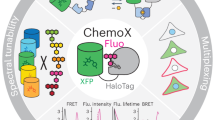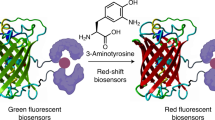Abstract
We developed genetically encoded fluorescence resonance energy transfer (FRET)-based sensors that display a large ratiometric change upon Zn2+ binding, have affinities that span the pico- to nanomolar range and can readily be targeted to subcellular organelles. Using this sensor toolbox we found that cytosolic Zn2+ was buffered at 0.4 nM in pancreatic β cells, and we found substantially higher Zn2+ concentrations in insulin-containing secretory vesicles.
This is a preview of subscription content, access via your institution
Access options
Subscribe to this journal
Receive 12 print issues and online access
$259.00 per year
only $21.58 per issue
Buy this article
- Purchase on Springer Link
- Instant access to full article PDF
Prices may be subject to local taxes which are calculated during checkout



Similar content being viewed by others
References
Vallee, B.L. & Falchuk, K.H. Physiol. Rev. 73, 79–118 (1993).
Lim, N.C. et al. Chem. Eur. J. 11, 38–49 (2005).
Maret, W. Biometals 22, 149–157 (2009).
Domaille, D.W., Que, E.L. & Chang, C.J. Nat. Chem. Biol. 4, 168–175 (2008).
Dittmer, P.J., Miranda, J.G., Gorski, J.A. & Palmer, A.E. J. Biol. Chem. 284, 16289–16297 (2009).
Bozym, R.A., Thompson, R.A., Goddart, R.B., Stoddard, A.K. & Fierke, C.A. ACS Chem. Biol. 1, 103–111 (2006).
van Dongen, E.M. et al. J. Am. Chem. Soc. 129, 3494–3495 (2007).
Vinkenborg, J.L., Evers, T.H., Reulen, S.W.A., Meijer, E.W. & Merkx, M. ChemBioChem 8, 1119–1121 (2007).
Hutton, J.C., Penn, E.J. & Peshavaria, M. Biochem. J. 210, 297–305 (1983).
Hohmeier, H.E. et al. Diabetes 49, 424–430 (2000).
Krezel, A. & Maret, W. J. Biol. Inorg. Chem. 11, 1049–1062 (2006).
Taki, M., Wolford, J.L. & O'Halloran, T.V. J. Am. Chem. Soc. 126, 712–713 (2004).
Mitchell, K.J. et al. J. Cell Biol. 155, 41–51 (2001).
Evers, T.H., Appelhof, M.A.M., Graaf-Heuvelmans, P.T.H.M. de Meijer, E.W. & Merkx, M. J. Mol. Biol. 374, 411–425 (2007).
Krezel, A. & Maret, W. J. Am. Chem. Soc. 129, 10911–10921 (2007).
Evers, T.H., Dongen, E.M.W.M., van Faesen, A.C., Meijer, E.W. & Merkx, M. Biochemistry 45, 13183–13192 (2006).
Silen, L.S. Stability Constants of Metal-ion Complexes, 2nd edn. (The Chemical Society, London, 1964).
Nguyen, A.W. & Daugherty, P.S. Nat. Biotechnol. 23, 355–360 (2005).
Acknowledgements
We thank S.M.J. van Duijnhoven for expressing and characterizing eZinCh, A. McDonald for assisting in the spinning disc confocal microscopy experiments, A. Tarasov for setting up the α-toxin incubation, H. Bayley (University of Oxford) for providing the α-toxin, C. Newgard (Duke University) for providing INS-1(832/13) cells, and L. Klomp and P. van den Berghe (University Medical Center Utrecht) and E.W. Meijer for their support at various stages of this research. M.M. and M.S.K. acknowledge support by the Human Frontier of Science Program (Young Investigator grant, (RGY)0068-2006). G.A.R. thanks the US National Institutes of Health for project grant RO1 DK071962-01, the Wellcome Trust for programme grants 067081/Z/02/Z and 081958/Z/07/Z, Medical Research Council (UK) for research grant G0401641, and the EU FP6 (“SaveBeta” consortium grant). T.J.N. and E.A.B. were supported by Imperial College divisional studentships.
Author information
Authors and Affiliations
Contributions
J.L.V., G.A.R. and M.M. designed research; J.L.V., T.J.N., E.A.B. and M.S.K. conducted experiments, J.L.V., T.J.R., E.A.B., M.S.K., G.A.R. and M.M. analyzed data and J.L.V., G.A.R. and M.M. wrote the paper.
Corresponding authors
Supplementary information
Supplementary Text and Figures
Supplementary Figures 1–14 and Supplementary Tables 1–5 (PDF 887 kb)
Supplementary Video 1
Ratiometric response of changes in cytosolic zinc for HEK293 expressing eCALWY-5. (AVI 6765 kb)
Supplementary Video 2
Ratiometric response of changes in vesicular zinc levels upon treatment of INS-1(832/13) cells expressing VAMP2-eZinCh with 10 μM monensin. (AVI 3797 kb)
Rights and permissions
About this article
Cite this article
Vinkenborg, J., Nicolson, T., Bellomo, E. et al. Genetically encoded FRET sensors to monitor intracellular Zn2+ homeostasis. Nat Methods 6, 737–740 (2009). https://doi.org/10.1038/nmeth.1368
Received:
Accepted:
Published:
Issue Date:
DOI: https://doi.org/10.1038/nmeth.1368
This article is cited by
-
Protective effect of the rare variant rs13266634C/T of the SLC30A8 gene in the genetic background of the development of type 2 diabetes in Turkish population
International Journal of Diabetes in Developing Countries (2023)
-
Single molecule microscopy to profile the effect of zinc status on transcription factor dynamics
Scientific Reports (2022)
-
Determination of the Dynamics of Change in the Intracellular Pool of Zinc Ions in Human Erythrocytes Using a FluoZin-3 Fluorescent Probe
Journal of Applied Spectroscopy (2021)
-
Extended sawhorse waveform for stable zinc detection with fast-scan cyclic voltammetry
Analytical and Bioanalytical Chemistry (2021)
-
Sub-nanomolar sensitive GZnP3 reveals TRPML1-mediated neuronal Zn2+ signals
Nature Communications (2019)



